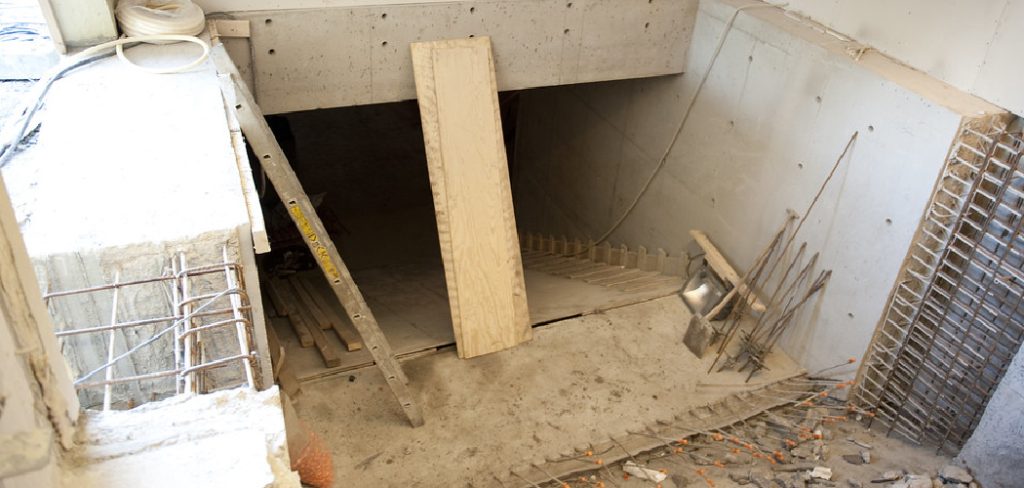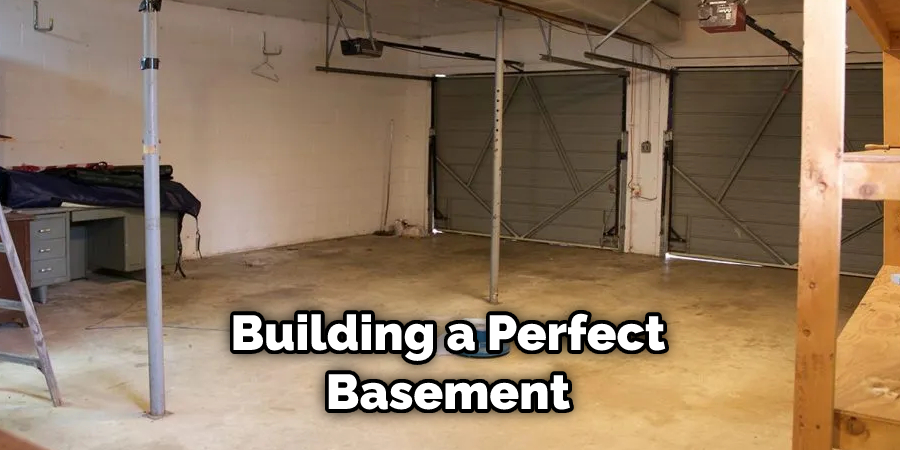Basements can be a great addition to your home, providing extra living space, storage, utility areas, and much more. Building a basement yourself is no small task, but it can save you money in the long run. With careful planning and preparation, constructing a basement is possible even if you don’t have any prior experience with construction or plumbing.

Building a basement can be an excellent way to maximize the use of space in your home. Basements offer extra property storage, living spaces, and added value. Additionally, they provide protection from flooding and other natural disasters. There are also several energy-saving benefits associated with basements since they tend to stay cooler during the summer months and warmer during the winter. In this blog post, You will learn in detail how to build a basement.
Step by Step Processes for How to Build a Basement
Step 1: Inspect the Property
Before starting any construction project, you should always inspect the property thoroughly to ensure that it is suitable for building a basement. Check for existing structures, grade levels, and any underground utilities or water sources. Also, research local zoning laws to ensure that a basement is allowed in your area.
Step 2: Estimate Costs
Once you’ve decided that a basement is feasible for your property, create a budget. Calculate the estimated costs of materials, labor, and equipment rental. Consider obtaining quotes from contractors to get an accurate estimate of what it will cost to build your dream basement. Before beginning any building projects, create a plan of the basement you want to build. Include blueprint measurements, the type of materials you will use, and any other details related to building your basement.
Step 3: Secure Permits
You’ll need to obtain permits from your local government before constructing your basement. This will ensure that all safety codes and standards are met and that the basement is up to code with local regulations. Once you have all permits in place, begin excavating the area where you plan to build your basement. Make sure to dig deep enough so that the walls of your basement are below the frost line.
Step 4: Lay Foundations
Once the area is excavated, begin laying your foundation walls. Make sure to double-check measurements and levelness before concrete or other materials are applied. A drainage system is an important component of a basement as it will help protect against moisture in the area. Install a proper sump pump and drainage system to ensure your basement stays dry and protected.
Step 5: Frame the Walls
Once the foundation is set, begin framing your walls with lumber or other materials. Make sure to use proper bracing techniques for stability and safety. Now that you have the frame of your basement in place, install any doors and windows you may want. Make sure to properly seal these openings with caulk or other materials for energy efficiency and air-tightness.
Step 6: Install Finishes
Add drywall and insulation to complete your new basement, then paint or wallpaper as desired. You may also want to add any fixtures and furniture pieces you desire for an inviting living space.
8 Safety Tips for How to Build a Basement

- Wear protective gear such as safety glasses, gloves, and a dust mask to ensure your safety during the process.
- Ensure the area is well-ventilated by using exhaust fans or other air circulation methods.
- Use appropriate tools for each job and follow all instructions carefully.
- Double-check all measurements before cutting or sawing anything.
- Use a level to ensure that the walls are even and straight.
- Secure any beams, ladders, and platforms you use during construction.
- Ensure that the electrical wiring meets up to safety standards and any other building codes in your area.
- Have a qualified professional inspect the work periodically to ensure it meets all standards and regulations.
Following these eight safety tips will help ensure that your Building a Basement project is completed safely and in compliance with local regulations.
How Can You Waterproof Your Basement Walls and Floor During Construction?
- The first step is to apply a waterproofing membrane to the walls and floor. Many different types of membranes are available, including rubberized asphalt, self-adhering sheet membranes, and liquid-applied coatings.
- It’s important that the membrane be installed properly according to manufacturer instructions; otherwise, it may not provide the desired protection.
- After the membrane has been applied, it’s important to install an interior drainage system to collect and divert water away from the basement walls and floor. This is usually done with a combination of drain tile, gravel, and sump pumps.
- Once the drainage system is in place, a waterproofing cover must be installed over the walls and floor. This can include various materials such as concrete board, vinyl sheeting, or paint-on sealant.
- Finally, it’s important to ensure that any penetrations in the wall or floor, such as pipes or wires, are properly sealed with caulking or masonry sealant.
By following these steps, you can ensure that your basement is waterproofed during construction and will remain dry for years to come.
How Do You Secure Your Basement Walls Against Flooding and Water Damage?

When it comes to building a basement, one of the most important considerations is waterproofing. A flooded basement can cause serious damage, costly repairs and frustration. That’s why it’s essential to secure your basement walls against flooding and water damage. First, consider whether you need an interior or exterior waterproofing system. An interior waterproofing system uses a membrane to protect against water infiltration, while an exterior waterproofing system is installed outside the walls and stops water before it even reaches the basement.
No matter which option you choose, make sure to use materials designed specifically for waterproofing basements. A good place to start is with a flexible sealant that can be applied as a thick layer with a paintbrush or roller. This will help keep moisture out of your walls and also prevent cracks from developing in the concrete. Another important step is to ensure there are no gaps between the walls and other surfaces, such as doors or windows. You should fill any gaps using either caulk or sealant.
How Can You Maximize Storage in Your Basement?
- Utilize Vertical Space: Install shelves and cabinets that go up to the ceiling for maximum storage. Use wall-mounted organizers to hang items like tools, cleaning supplies, and other miscellaneous items.
- Take Inventory of What You Need to Store: Make a list of what you need to store in your basement, such as seasonal items like holiday decorations and outdoor furniture. This will help you plan the layout of your storage solution.
- Use Rolling Carts: Store items on rolling carts to maximize space and make it easy to access things when needed. This is especially helpful for those with many items that need to be moved around frequently.
- Install Hooks and Hangers: Use wall-mounted hooks and hangers to hang items like bikes, pool floats, and other large objects that can take up a lot of space when not in use.

- Utilize Storage Containers: Place items like boxes, bins, baskets, and suitcases in designated areas for easy organization. Label the containers so you know what’s inside without opening them up.
- Use a Peg Board System: Install a peg board system to hang smaller items like tools and equipment, keeping them off the floor but still within reach when needed.
- Invest in Furniture Solutions: Invest in furniture solutions like shelving units and cabinets to maximize storage space. This is especially helpful if you have many smaller items that need to be organized.
By following these simple steps, you can quickly and easily maximize the storage in your basement and ensure that all your belongings are kept safe and secure.
What Other Considerations Should You Make When Building a Basement?
When building a basement, there are several other considerations to keep in mind. You’ll need to ensure the area is properly sealed from moisture and have it inspected for safety concerns. Additionally, you must ensure that your basement is adequately heated and ventilated so that it is comfortable to inhabit year-round. Installing a sump pump system is also important and helps to protect against flooding. You should also consider installing a backup power supply in case of an outage and a dehumidifier to help regulate humidity levels.

Finally, you may want to install soundproofing measures if your basement is near a noisy area such as a busy street or railway line. Taking the time to consider these additional elements will help make your basement more comfortable and usable. With the right planning, you can make sure your basement is a safe and enjoyable space for all.
Conclusion
In conclusion, building a basement is an ambitious project that requires careful planning and execution. There are a few steps to take when beginning the process, such as obtaining the necessary permits and designing your space. You’ll need to ensure you have all the materials and tools you’ll need for the project, including lumber, concrete, insulation, and waterproofing products.
You can safely and successfully build your own basement with the correct preparations and knowledge. I hope this article has been beneficial for learning how to build a basement. Make Sure the precautionary measures are followed chronologically.
